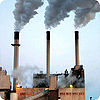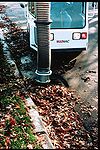
Difference between revisions of "Industrial & Commercial Pollution Prevention Methods"
m |
m |
||
| Line 18: | Line 18: | ||
</tr> | </tr> | ||
<tr> | <tr> | ||
| − | <td>Emission Regulation | + | <td>Emission Regulation [[Pollution prevention#Photo credits|<sup>1</sup>]]</td> |
<td>Follow local, state and federal regulatory requirements for control of air emissions.</td> | <td>Follow local, state and federal regulatory requirements for control of air emissions.</td> | ||
| − | <td>[[File: | + | <td>[[File:Emission regulation.jpg|center|100px]]</td> |
</tr> | </tr> | ||
<tr> | <tr> | ||
| Line 58: | Line 58: | ||
</tr> | </tr> | ||
<tr> | <tr> | ||
| − | <td>Sanitary Sewer System Maintenance | + | <td>Sanitary Sewer System Maintenance [[Pollution prevention#Photo credits|<sup>2</sup>]]</td> |
<td>Regularly inspect and flush sanitary pipes to ensure that there are no leaks in the system and that the system is properly functioning.</td> | <td>Regularly inspect and flush sanitary pipes to ensure that there are no leaks in the system and that the system is properly functioning.</td> | ||
| − | <td>[[File: | + | <td>[[File:Sanitary storm sewer maintenance.jpg|center|100px]]</td> |
</tr> | </tr> | ||
</table> | </table> | ||
[[category:table]] | [[category:table]] | ||
Revision as of 16:29, 12 March 2013
Industrial & commercial pollution prevention methods.
Link to this table
| Practice | Method | Image |
|---|---|---|
| Temporary Construction Sediment Control | Implement and encourage practices to retain sediment within construction project area; see Temporary Construction Erosion and Sediment Control Factsheets for additional information | |
| Wind Erosion Control | Institute a local program for wetting of open construction surfaces and other sources for windblown pollutants. | |
| Emission Regulation 1 | Follow local, state and federal regulatory requirements for control of air emissions. | |
| Material Storage Control 1 | Reduce or eliminate spill and leakage loss by properly inspecting, containing, and storing hazardous materials and having a cleanup plan that can be quickly and efficiently implemented. | |
| Dumpster and Landfill Management | Ensure that contaminated material is contained to prevent solid and/or liquid waste from being washed into storm sewer systems or water bodies. | |
| Better Turf Management 1 | Ensure that mowing, fertilization, pesticide application, and irrigation are completed in ways that will prevent or reduce grass clippings, sediment, and chemicals from entering storm sewer systems; use native vegetation where possible. | |
| Better Parking Lot Cleaning 1 | Maintain streets and parking lots frequently and especially in the spring by sweeping, picking up litter, and repairing deterioration; pressure wash pavement only as needed and avoid using cleaning agents. | |
| Better Impervious Surface Deicing 1 | Properly store and conservatively apply salt, sand, or other deicing substances in order to prevent excessive and/or unnecessary contamination; implement anti-icing and prewet salt techniques for increased deicing efficiency. | |
| Proper Vehicle Management 1 | Ensure that vehicles are fueled, maintained, washed and stored in a manner that prevents the release of harmful fluids, including oil, antifreeze, gasoline, battery acid, hydraulic and transmission fluids, and cleaning solutions. | |
| Storm Sewer System Maintenance | Regularly clean debris from storm sewer inlets, remove sediment from catch basin sumps, and remove any illicit connections to storm sewer systems. | |
| Sanitary Sewer System Maintenance 2 | Regularly inspect and flush sanitary pipes to ensure that there are no leaks in the system and that the system is properly functioning. |










